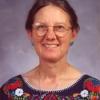Enormous ochre stone slab walls shout loudly as I drive through Church Rock, N.M., to Red Water Pond (near Gallup on the Navajo, or Diné, nation). I drive this road each year around July 16 to attend the commemoration of the Church Rock Radioactive spill. But today the air is different.
Luke 19: 39-40 moves on the wings of the desert wind: “Some of the Pharisees in the crowd said to him, ‘Teacher, order your disciples to stop.’ He answered, ‘I tell you, if these were silent, the stones would shout out.’
Stones shout loudly today in many places. I drive to the Navajo community of Red Water Pond. I listen intently. Families in this rural region suffer from high rates of cancer and other ailments due to exposure from uranium mining and milling and the second largest radioactive contamination accident in U.S. history. Most people remember the 1979 Three Mile Island disaster, but few have heard of the uranium tailings pond break that sent contaminated waters from near Gallup, N.M., to as far as Winslow, Ariz., 35 years ago – that same year. Even today the contamination rests under foot and threatens distant waterways and lands.
At this moment, I am more sensitive to the story of stones and water and soil. Just three weeks ago part of our family farm in Kansas was contaminated by a pipeline gas explosion that sent a black cloud 500 feet into the air for 15 minutes to settle upon farms in a three-mile stretch. I am heartsick about the dying maple and oak trees that my parents, now deceased, planted more than 30 years ago, and about my brother’s crops and the birds, our house covered in an oily substance – and so much more. Because the pipeline company is not handling the accident properly, my brothers and neighbors met with a lawyer today. I pray as I drive between the ever present ochre and red stone mesas.
But my sorrow is multiplied many times over. My prayer, like the stones, cries out to people in rural Africa, the Philippines and Latin America whose land, water and air are despoiled by extractive industries. They do not have access to lawyers. They do not receive economic benefits. Many wait decades for clean-up. When the spills, accidents and pollution are on one’s farm or homeland, the story is very personal and flows from heart through veins and affects the entire body.
A recent quote by Pope Francis, from Evangelii Gaudium describes the sentiment aptly:
Thanks to our bodies, God has joined us so closely to the world around us that we can feel the desertification of the soil almost as a physical ailment, and the extinction of a species as a painful disfigurement. Let us not leave in our wake a swatch of destruction and death which will affect our own lives and those of future generations.
My small car reaches the end of the road and parks amidst the many pick-up trucks. Sun beams through chamisa and sage, which is wafted along with the scent of sand by the cool early morning air. Soon we begin the two-mile walk to where the tailings pond’s dam broke and still contaminates the area with high radioactive readings. The mostly Navajo crowd is filled with children, some carrying signs that say, “Stop modern colonialism; don’t pollute our land.” It is a privilege to be here.
Before we begin, a holy man, Mr. Bluehouse, offers a prayer to the four directions and for the mending of the masculine and feminine. We offer prayers with pinches of white corn meal symbolizing the atoms and particles that make up the entire cosmos and universe that flows through our bodies. May this Superfund site be healed and may the human family be healed.
The people who live here have worked in the mines, even building homes with uranium tailings, since the ‘40s, when the U.S. government was the sole mine and mill procurer. They were not told of the dangers. Workers before 1971 receive health and other compensation, but those in the crowd who worked after that time are not covered. Only now the first health evaluation is being done, the Navajo Birth Cohort Study. One Navajo scientist who was called away from Three Mile Island to address the spill 35 years ago drove 175 miles today to speak. His soul is filled with images of people with cancer, Down syndrome, cleft palates, thyroid and lung diseases – all related to the uranium industry. His message: Future uranium mining must stop, and clean-up must happen.
At the site of the spill Mr. Bluehouse prays in the name of Spirit of Monster Slayer Born for Water and White Shell Changing Woman. Both are very important holy ones to the Navajo and part of their creation stories. This holy man’s prayer spreads on wind wings beyond this place:
We have suffered too long. We have been stuck in the sand too long.
Protect us in this place of journey where we leave footsteps.
Even when our footsteps are in pain, may we find joy . . .
Stand with us in this place . . .
In that way may we move forward with integrity, honesty and humility.
We will achieve.
We shall achieve.
We are achieved.
Lead us from before and into today.
[Sr. Joan Brown, OSF, is a member of the Rochester, Minn., Franciscan community. She lives in Albuquerque where she is the executive director of New Mexico Interfaith Power and Light.]

